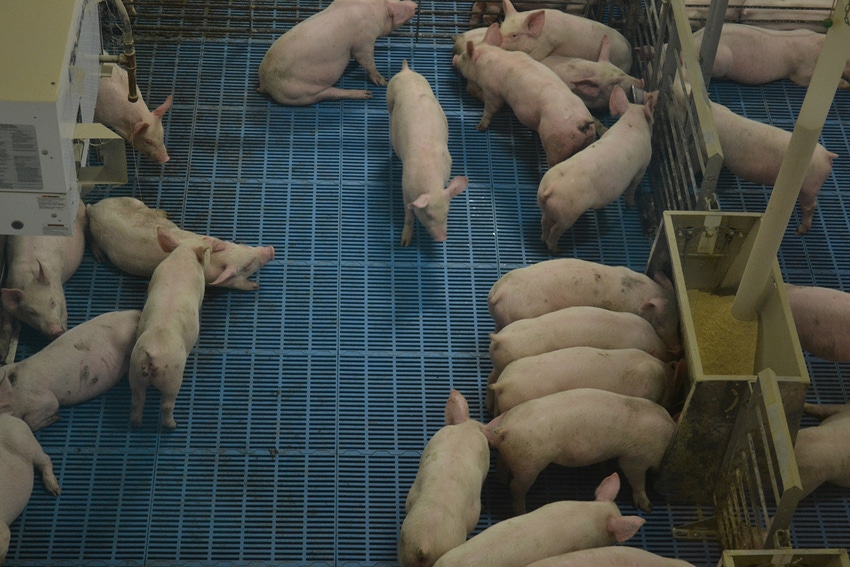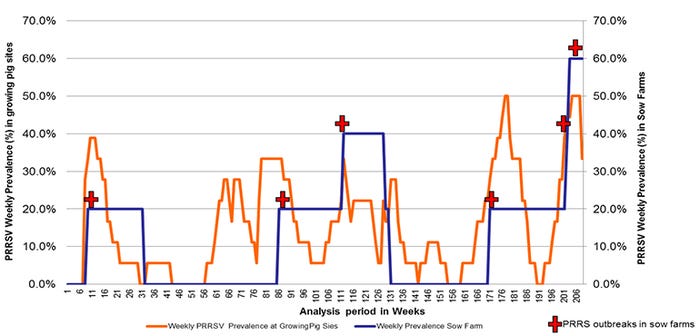Study points toward the need to do more research in finishing pigs to advance the control and eventual elimination of PRRSV from regions.
March 12, 2019

By Jose Angulo, University of Minnesota and Zoetis; Montserrat Torremorell, University of Minnesota; Paul Yeske, Swine Vet Center; and Andreia Arruda, The Ohio State University
Porcine reproductive and respiratory syndrome virus continues to be one of the most important pathogens affecting the U.S. swine industry1. Significant progress has been made in the control and prevention of PRRSV infections in sow herds, and cost to the industry has somewhat decreased2. However; if we want to significantly advance PRRS control, we need to shift gears and focus on growing pigs. PRRSV is widespread in growing pigs but we know little about the dynamics of PRRSV circulation, incidence of infections, prevention protocols and even the risk that growing pigs represent to sow farms.
We conducted a retrospective study that suggests that PRRSV circulation in growing pigs is a significant threat to sow farms’ PRRSV stability. Our results were not surprising considering growing pigs can be reservoirs and amplifiers of PRRSV; which in turn could result in a source of infection back to sow farms.
We studied five historically negative, filtered sow farms surrounded by 18 growing pig sites located all together in a geographical area of approximately 10-mile radius. All these sites were under the control of the same ownership with no outside pigs coming into the area. The original goal was to eliminate PRRSV and maintain the filtered sow farms PRRSV negative but several PRRSV outbreaks in finishing sites were observed and consequently sow farms suffered reproductive outbreaks.
With the intention to investigate these events, a retrospective analysis was done using PRRS historical surveillance data from all sites for a period of four years. PRRSV surveillance consisted in monthly blood-serum testing in all sow farms, and oral fluids in nursery and finishers along with blood testing in selected herds to obtain an ORF5-sequence in every group of known infected pigs. We studied PRRSV incidence in the herds and the temporal association of PRRSV breaks between the sow and growing pig herds.
During the four-year study period, there was an 80% probability of having at least one reproductive outbreak in the sow herds with the estimate of having a PRRSV break in the filtered farms every 3.33 years. Interestingly, in several cases, we observed the same PRRS virus sequence (defined as at least 98% similar using ORF-5 sequencing) in growing pig sites before outbreaks would take place in the sow farms. There were 11 distinct new virus introductions into the growing pig herds during the study period.
When we analyzed PRRSV weekly prevalence in growing pig sites and sow farms, the risk of infection in the sow farm increased as prevalence of infection in the growing pigs increased (Figure 1).

Figure 1: PRRSV weekly prevalence in filtered sow farms and growing pig sites
Furthermore, a multivariable linear regression model showed an association between weekly PRRSV prevalence in growing pigs and weekly prevalence in sow farms after adjusting for season and sow farm PRRSV prevalence in the previous week.
This study showed an association between prevalence of PRRS in growing pigs and risk of reproductive PRRSV outbreaks in sow farms, at least in the system under study. Overall this study points toward the need to do more research in finishing pigs if we want to significantly advance the control and eventual elimination of PRRSV from regions.
References
1. Holtkamp D, Kliebenstein J, Neumann E, Zimmerman J, Rotto H, Yoder T, et al. Assessment of the economic impact of porcine reproductive and respiratory syndrome virus on United States pork producers. Journal of Swine Health and Production. 2013;21(2):72-84
2. Marlys Miller. Annual PRRS Cost Fall $83.3 Million. Productivity gains blunt the impact of PRRS on the U.S herd. Pork Checkoff Report P 38-39. Summer 2017.
Sources: Jose Angulo, Montserrat Torremorell, Paul Yeske and Andreia Arruda, who are solely responsible for the information provided, and wholly owns the information. Informa Business Media and all its subsidiaries are not responsible for any of the content contained in this information asset.
You May Also Like



